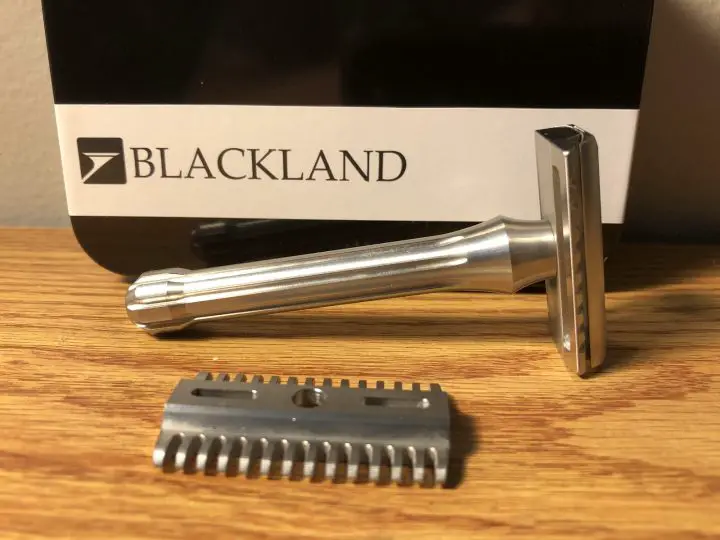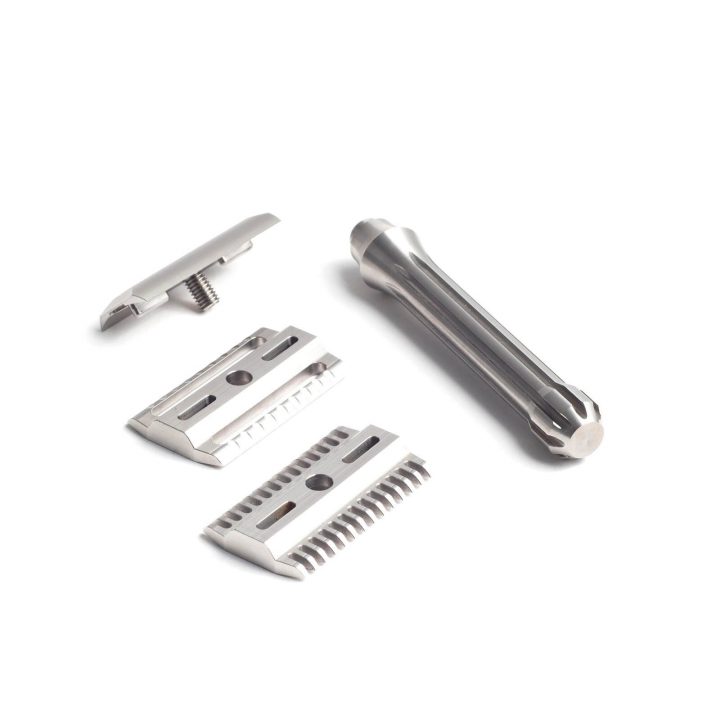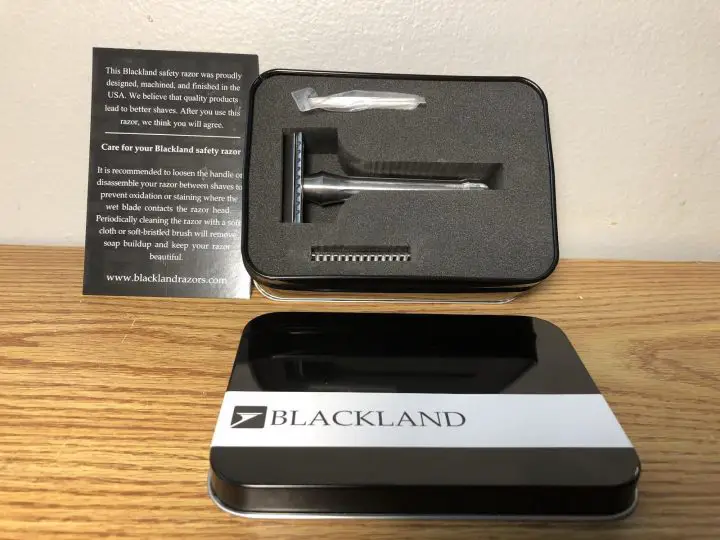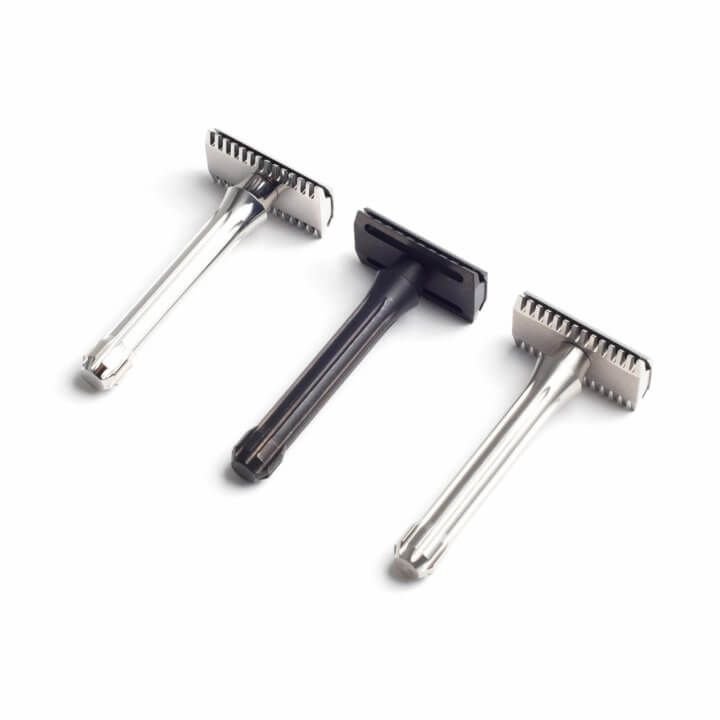
The Blackland Razor Company has established a reputation amongst wet shavers all over the world. Built upon the concept that high quality tools can also be works of art, the Blackland Razor Company produces razors that are built tough and made to last a lifetime.
To Shave With Blackland
[Ed. Note: Blackland links are affiliate.]
The razors are designed and built in the USA and consist of either polished, anodized, or machined finishes. There are currently two models produced, the Blackbird which holds double edge safety razor blades and the Sabre which holds single edged “Gem style” blades. Both of these models start with the same base price and vary with additional options.
Several months ago I started looking up some information regarding the Blackland company and wanted to find out more about the team behind it. Unfortunately my search came up with only a few tidbits of information. I decided to go directly to the source.
I contacted Shane, the owner of Blackland Razors, and was pleasantly surprised when he wrote back saying he would be delighted to share his story. I sent him an email interview and his responses were more than I would ever expect. It was so great I wanted to share it with you all!
Here is the complete interview:
What motivated you to start the Blackland brand?
Blackland LLC began by accident in 2014. I was in school at the time and found myself deeply interested in designing products and bringing my ideas to life. I was actively cycling and doing triathlons so a lot of my product concepts centered around those interests. My notebooks filled up with illegible doodles as I struggled to get my mental inventions out of my head and into reality. With poor coordination and no technical design skills my progress stalled. I realized that if I wanted to bring my cycling concepts to the physical space, I would have to learn computer-aided design (CAD).
I set out to learn basic CAD and this is where the Blackland story really begins. The first few weeks and months were spent cutting my teeth on incredibly basic free software designed for children. As time went on, both my skills and the sophistication of my software grew until I was able to model relatively complex designs. I still didn’t quite have the capability to design my cycling products so I started to practice by modeling different items around the house.
Around this time I had begun wet shaving and one morning after a shave I looked down at the razor in my hand and decided it would be the perfect item to practice my CAD skills on. DE razors are a wonderful combination of simple design concepts coupled with fairly intricate and specific geometries. These characteristics made the DE razor the perfect item to practice on.
And practice I did. The first model I made was hideous, but I was excited and decided to have it 3d printed to see if it would shave. It shaved about as well as a steak knife, but I was hooked. I went back to drawing board and made a new prototype. And then another. And another. Finally, after well over a dozen models, the Blackbird was born.
Blackland LLC was founded immediately thereafter. The name Blackland is derived from a loose translation of my German last name, Swartzlander. This roughly translates to “black lander”, likely referring to the Black Forest region of Germany.
How many versions/prototypes did you work with the Black Bird and Sabre before your were satisfied with the final product?
The Blackbird required more than a dozen prototypes before the design was finalized. Many of those early prototypes were terrible failures as I set out with very little understanding of the design principles behind creating a high-performance safety razor. The Blackbird was designed to be the perfect razor for my personal shaving preferences and bear type. This required a highly efficient razor that could hack through a thick, coarse beard without leaving my skin raw and irritated. It took a lot of trial and error before settling on the specific shaving geometry that makes the Blackbird incredibly efficient without being overly aggressive.
When design on the Sabre began, I knew how I wanted the razor to perform. The design challenges for the Sabre revolved around how to deal with the unique shape of the GEM blade. Early one I decided that the Sabre needed to meet the following criteria: head perfectly centered over the handle, no small extra parts to drop down the sink, blade guards to cover the sharp blade corners, and a simple blade assembly mechanism. I tried a few dozen methods to mount the blade before settling on the simplest and most reliable design. The Sabre is a three-piece razor that uses a modified standard m5 x 0.8mm threaded post to fit the narrow center hole on a GEM razor.

How did you get into traditional wet shaving?
I believe it all began about four years ago. I was reading an article on Yahoo! about how to shave better with a cartridge razor. In the comments section somebody brought up how safety razors deliver better shaves more cheaply. I dove headfirst into the strange world of wet shaving and soaked up everything I could learn about it. Merissa gave me my wet shaving kit for my birthday that year and things have clearly progressed form there.
Do you have any new products in mind?
We are currently working on a more aggressive Sabre base plate as an option and a Sabre stand. Both of those items will be released in the coming. The next big product is a slant razor that is in the pipeline and will hopefully be available this year. Our goal for Blackland is to offer a full range of finely-crafted razors that will accept all the standard blade types. Expect big things from Blackland in 2018.
How long is the production process? How many steps etc?
The head pieces of our razors are made on a 5-axis CNC mill in two operations per piece. Each piece begins as a solid chunk of stainless steel before being machined. As an example, the underside of the top cap is milled first, including the threaded post. Then those pieces are affixed to a jig and the top of the part is milled. The basic process is similar for the base plates and top caps on the Sabre and Blackbird.
Our handles are made in a special type of lathe that can both turn and actively mill the part. This is how we are able to machine the long grooves in the Blackbird handle and the cutouts on the Sabre handle. The handle is turned, creating the profile, and the grooves are milled all on the same machine.
The production process varies in length depending on the razor and variant (open comb or safety bar), but typically around forty minutes per machined razor is standard. After the machining process, the base plates are hand finished to ensure that the leading edges of the base plate are smooth and comfortable on the skin.
Our black oxide razors are then sent to receive the finish treatment before being returned to us. The polished razors receive tedious hand sanding in house to prepare them for final polishing. They are then sent to a polishing partner for buffing and polishing before returning to us for final touch-ups. Polishing approximately doubles the production time of our razors, but the stunning mirror finish is worth it.
Any other hobbies that interest you?
I enjoy the outdoors, playing guitar, coffee, craft beer, exercise, and road trips. I also love pool, but my skills don’t come close to matching my enjoyment of the game so I’d like to get a lot better.
Blackland Blackbird Review

I was fortunate enough to pick up a Blackbird double edge safety razor with both the open comb and safety bar plates.
*Disclaimer: I used this razor primarily for several weeks and keep it in my regular rotation today. It’s important to understand that your mileage may vary when using particular razors, soaps and aftershaves. What may work for me may not work for you.
Packaging:

While I never judge a book by it’s cover it’s important to mention the packaging in this particular case. The Blackbird came to me in an aluminum tin packed with a custom cut foam insert that perfectly fits all parts of the razor. The outside of the tin consists of an all black design with a white stripe.
The packaging does not reflect the shave in anyway shape or form but it’s a nice touch when you spending around $200 for a razor. Just like buying a fine bottle of scotch or a new pen the way it’s packed does have an impact with consumers.
Needless to say I was very impressed in the packaging and find it to be one of the best I have seen in my time with traditional wet shaving.
The Blackland Blackbird Razor


The Blackbird’s design is that of a typical modern day 3 piece double edge safety razor with a little twist. Inspired by the SR-71 “Blackbird” aircraft the design is unique to say the least. It’s sleek lines and deep grooves make the razor look like it’s ready to take off.
Composed of solid stainless steel all Blackbirds are machined in Illinois and then sent to be finished in Ohio making the razor 100% American made. Upon making your purchase you have the option of choosing 3 finishes. The first finish “machined” is unrefined and is a great representation of how stainless steel looks. Think of a 1980’s Delorean from Back to the Future. The second “black oxide” finish represents the Blackbird aircraft in the flesh. The chemical reaction forms a bond to the metal to create a “patina” like finish that is truly unique to each razor. The third finish “polished” is where the steel is worked until a mirror shine is achieved.

Blackbird Concept
Finally the specifications. There are two baseplates available for the choosing. An *open comb and *safety bar which both have a gap of around .58 mm. Although both plates have the same gap, the open comb is a tad more aggressive. The choice is based upon preference or you can just get both for a nominal charge.
*A “safety bar” base plate covers the entire length of the blade which reduces the risk of irritation and cuts while an “open comb” base plate exposes part of the blade which allows greater lather flow and efficiency.
Performance
The first thing I noticed when first handling the Blackbird was the weight. At 98 grams the razor is heavy but it’s evenly distributed. The handle with its ridges provide a better than adequate grip and feel very comfortable in hand.
Loading the blade is standard as you would do with any 3 piece double edge razor. There was no difficulty tightening the handle, which has a special that fits the handle perfectly.
Now for the most important part…The shave!
As with any razor it’s very important to take your time and really learn how the razor works. I like to use a milder blade for the first few shaves just so I can figure out how aggressive the razor really is. I always start off with a Derby blade before moving on to more advanced blades such as Feather.
Shaving with the grain (WTG) posses a huge threat for unsuspecting whiskers. The first stroke reminded me of using a wedge straight razor. It felt solid, and the razor made just enough noise to remind you it’s shaving. I used extremely light pressure so to not over compensate for the weight ( Some wet shavers tend to use more pressure when shaving with a heavier razor.) and found this to be effective with the several types of blades I tried.
The handle has an awesome grip that feels very comfortable and will not slip. The razor feels solid and the weight is evenly distributed so it’s not top or bottom heavy.
I found that using a 30-40 degree angle to be just perfect when shaving with the grain and provided an irritation free, clean and close shave. If you have trouble finding the perfect angle there is a trick with the Blackbird that really works. Simply look at the top of the razor and you’ll see two lines angling down. Try to lead your stroke with those lines and record your results. I think you’ll be pleasantly surprised with the outcome.
Shaving against the grain (ATG) required a little patience and a greater angle of attack. For some reason I found a 45 degree angle to work really well when ATG. At this point around 80% of the stubble is already removed so a more mild technique can work. Just like WTG I found that a light touch went along way. Use the same concept with leading with the line as you would with shaving with the grain only use a slightly less angle.
When using the open comb plate I found the same methods for both WTG and ATG works the same. Maybe use just a little more caution as the open comb is a tad more aggressive.
[Ed. note: there is also now the Blackbird Lite, a toned-down version of the Blackbird. With a modified base plate that provides half the blade feel, the Blackbird Lite brings the Blackbird shaving experience to those looking for a more forgiving razor. Titanium versions of these razors are also available.]
Overall
The Blackland Blackbird is a quality piece that utilizes a past concept with modern design and technology. This razor is is engineered to last a lifetime and I am certain with proper care it will last many years.
I would use caution with this razor as I feel that it requires a little practice and some general knowledge of double edge safety razors, especially when using the open comb guard. I wouldn’t recommend this razor to a beginner, and I don’t feel it is marketed in that way to begin with.
The price starts at $200 for the razor and one guard and goes up to $255 with both guards. Pricing is in line with similar razors such as Wolfman WR-1, Above the Tie, and Timeless models of similar construction.
About the Author:
Joe Borrelli is a long-time wet shaving enthusiast and collector. He hosts the Wet Shaving News/Talk Podcast , runs his own self-funded website http://shavestraightandsafe.com/ and operates a YouTube channel to help inform the community of new information involving the wet shaving world. Joe holds a BBA from Florida Atlantic University, and currently works for the nation’s largest wine/spirits/beer retailer. In his spare time, he enjoys traveling with his wife Linda, reading, writing, outdoor activities and collecting wet shaving apparel. Find out more about Joe here.
